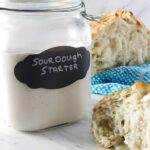Making a Sourdough Starter with Pineapple Juice
A sourdough starter is the first step to making authentic sourdough bread. Creating your own sourdough starter is easy, and with proper care, it can last for years. This recipe uses pineapple juice to help give the initial growth of wild yeast a headstart.
Servings: 1 cup of starter
Ingredients
- all-purpose flour see notes
- Unsweetened Pineapple Juice
- Water non-chlorinated
Instructions
Day 1: Start Your Starter
- In a small jar or bowl, mix 2 tablespoons flour (15 grams) and 2 tablespoons unsweetened pineapple juice (30 grams). This is the beginning of your starter.
- Stir 2–3 times during the day to mix in air. Keep it loosely covered with a paper towel or coffee filter to allow airflow while keeping out dust and insects.
Day 2: First Feeding
- Add 2 tablespoons flour (15 grams) and 2 tablespoons unsweetened pineapple juice (30 grams) to the starter you made on Day 1.
- Stir well to combine, then stir 2–3 times during the day to keep it aerated. Cover loosely as before. You won’t see any activity yet, the yeast is still getting established.
Day 3: Second Feeding
- Add ¼ cup flour (30 grams) and ¼ cup unsweetened pineapple juice (60 grams) to the existing starter and stir well.
- You may start to notice bubbles. If not, don’t worry, some starters take longer. There’s no need to discard any starter yet, just feed it, stir it, and wait.
Day 4: Begin Discard and Regular Feeding
- Starting today, switch from pineapple juice to water. Keep only ¼ cup (about 60 grams) of your starter and discard the rest.
- Add ¼ cup water (60 grams) and ½ cup flour (60 grams) to the remaining starter and stir well. Transfer the starter to a quart-size jar or larger so it has plenty of room to rise without overflowing.
Day 5: Continue Feeding
- Repeat the same feeding process as Day 4. If your starter doubles in size in less than 12 hours, start feeding it twice per day. If it’s still slow, keep feeding once a day. Some starters just need more time to get going.
Day 6: Maintain the Schedule
- Continue discarding down to ¼ cup (60 grams) of starter before each feeding, then add ¼ cup water (60 grams) and ½ cup flour (60 grams).
- Feed once or twice a day depending on how active your starter is. Look for a consistent rise and fall between feedings.
Day 7: Ready to Use (or Keep Feeding if Needed)
- If your starter is reliably doubling in size between feedings, it’s ready to use in baking. Remove the amount needed for your recipe, then feed what remains at a 1:1:1 ratio by weight. For example, 20 grams starter, 20 grams water, 20 grams flour.
- If your starter still isn’t doubling, keep feeding daily until it’s strong and active, which can sometimes take another week or two.
Storing and using your sourdough starter:
- Room temperature maintenance: If you plan to bake often, you can keep your starter at room temperature. Feed it once or twice a day (following the Day 4 feeding amounts) depending on how quickly it rises and falls between feedings.
- If you won’t be baking for a while, store your starter in the refrigerator and feed it once a week using a 1:1:1 ratio by weight (equal parts starter, water, and flour). As an example, you might keep about ¼ cup starter (around 60 grams), then feed it with ¼ cup water (60 grams) and ½ cup flour (60 grams).
- The flour amount looks larger because flour is lighter than water; ½ cup flour weighs about the same as ¼ cup water. The exact amount isn’t critical. Just keep the ratio the same.
- When you’re ready to bake again, take the starter out of the fridge 1–3 days before you need it and feed it twice a day until it’s fully active. Keep the lid loose so gases can escape.
Notes
Starter timing: It can take longer than 7 days for a starter to be ready for baking. If yours is still slow, keep following the Day 4 feeding routine until it’s reliably doubling in size.
Dormant stage: Don’t discard your starter if it suddenly stops showing activity after bubbling well for a few days. If it happens, stop feeding for 24–48 hours and leave it loosely covered at room temperature. Then resume your regular feeding schedule. It may take a couple of feedings before it perks up again.
Flour choice: For the first two days, using a whole grain flour (such as whole wheat or rye) can give your starter an extra boost because it contains more nutrients and naturally occurring microorganisms than white flour. White flour works too, but it may take longer to see activity. Always use unbleached flour, bleaching agents can slow yeast growth.
Water:Use non-chlorinated water if possible. Chlorine can harm the wild yeast and bacteria you want in your starter, especially when it’s young and still getting established.
Temperature: Keep your starter in a warm spot, ideally between 70–75°F. Temperatures above 78°F can encourage unwanted bacteria, while cooler conditions can slow yeast activity and delay readiness.
Pineapple juice:Use pineapple juice only for the first three days. Do not continue feeding it with pineapple juice after that point. Once your starter is established, the extra acidity can harm the yeast.
Flavor development: The longer you maintain your starter, the more flavor it will develop. After a month or two, you’ll notice a richer, more complex taste in your baked goods.
Measurement note: A 1:1:1 feeding ratio means equal weights of starter, water, and flour. For volume measurements, this will look uneven because water is heavier than flour. For example, ¼ cup water weighs about the same as ½ cup flour.
Nutrition
Serving: 1tablespoon of starter | Calories: 14kcal | Carbohydrates: 3g
